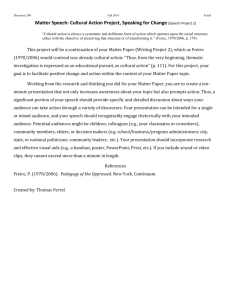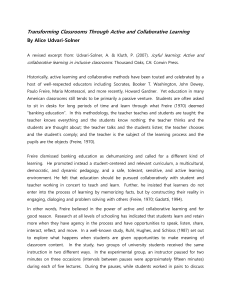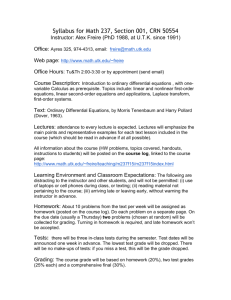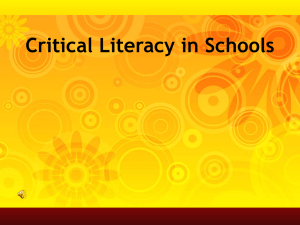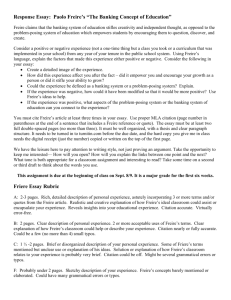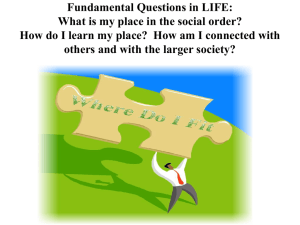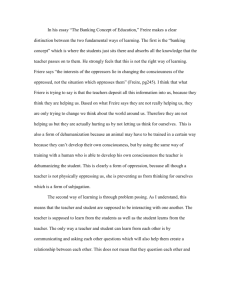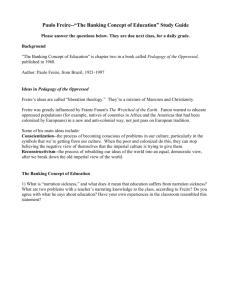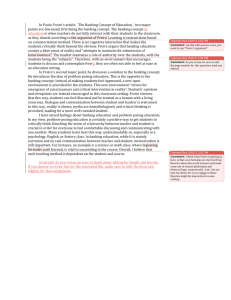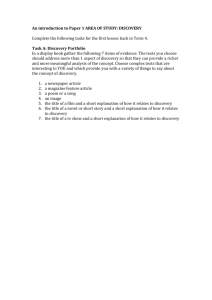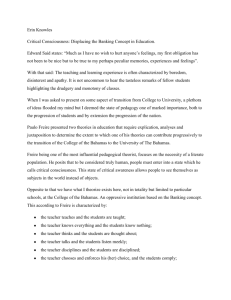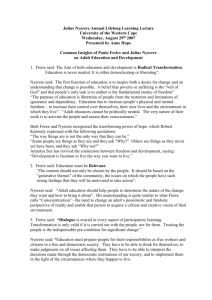The art of taking a critical stance - critical
advertisement
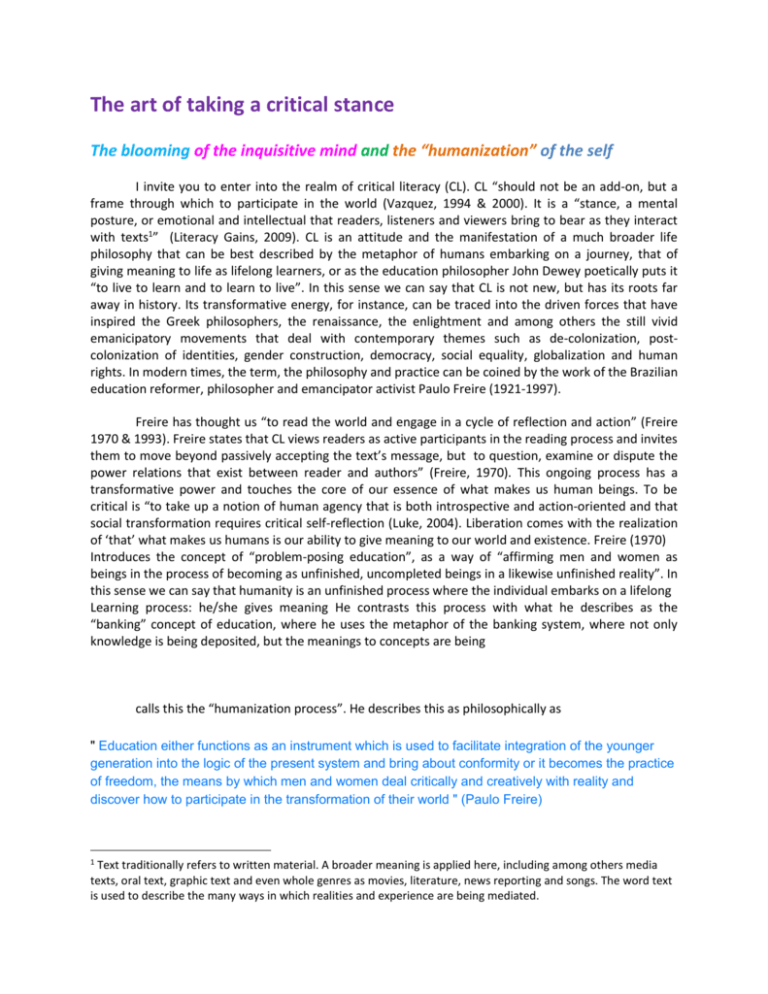
The art of taking a critical stance The blooming of the inquisitive mind and the “humanization” of the self I invite you to enter into the realm of critical literacy (CL). CL “should not be an add-on, but a frame through which to participate in the world (Vazquez, 1994 & 2000). It is a “stance, a mental posture, or emotional and intellectual that readers, listeners and viewers bring to bear as they interact with texts1” (Literacy Gains, 2009). CL is an attitude and the manifestation of a much broader life philosophy that can be best described by the metaphor of humans embarking on a journey, that of giving meaning to life as lifelong learners, or as the education philosopher John Dewey poetically puts it “to live to learn and to learn to live”. In this sense we can say that CL is not new, but has its roots far away in history. Its transformative energy, for instance, can be traced into the driven forces that have inspired the Greek philosophers, the renaissance, the enlightment and among others the still vivid emanicipatory movements that deal with contemporary themes such as de-colonization, postcolonization of identities, gender construction, democracy, social equality, globalization and human rights. In modern times, the term, the philosophy and practice can be coined by the work of the Brazilian education reformer, philosopher and emancipator activist Paulo Freire (1921-1997). Freire has thought us “to read the world and engage in a cycle of reflection and action” (Freire 1970 & 1993). Freire states that CL views readers as active participants in the reading process and invites them to move beyond passively accepting the text’s message, but to question, examine or dispute the power relations that exist between reader and authors” (Freire, 1970). This ongoing process has a transformative power and touches the core of our essence of what makes us human beings. To be critical is “to take up a notion of human agency that is both introspective and action-oriented and that social transformation requires critical self-reflection (Luke, 2004). Liberation comes with the realization of ‘that’ what makes us humans is our ability to give meaning to our world and existence. Freire (1970) Introduces the concept of “problem-posing education”, as a way of “affirming men and women as beings in the process of becoming as unfinished, uncompleted beings in a likewise unfinished reality”. In this sense we can say that humanity is an unfinished process where the individual embarks on a lifelong Learning process: he/she gives meaning He contrasts this process with what he describes as the “banking” concept of education, where he uses the metaphor of the banking system, where not only knowledge is being deposited, but the meanings to concepts are being calls this the “humanization process”. He describes this as philosophically as " Education either functions as an instrument which is used to facilitate integration of the younger generation into the logic of the present system and bring about conformity or it becomes the practice of freedom, the means by which men and women deal critically and creatively with reality and discover how to participate in the transformation of their world " (Paulo Freire) 1 Text traditionally refers to written material. A broader meaning is applied here, including among others media texts, oral text, graphic text and even whole genres as movies, literature, news reporting and songs. The word text is used to describe the many ways in which realities and experience are being mediated. A Collection of Critical Questions CL involves an active and challenging approach to reading and textual practices Critical Literacy involves the analysis and the critique of the relationships among texts, language, power, social groups and social practices. It shows us ways of looking at written, visual, spoken, multimedia and performance texts to question and challenge the purpose, attitudes, values and beliefs that lie beneath the surface. What kind of critical questions can we ask of texts? These questions can be asked of most spoken, written, visual, multimedia and performance texts. They encourage students to question beliefs that are often taken for granted. Textual purpose(s) What is this text about? How do we know? Who would be most likely to read and/or view this text and why? Why are we reading and/or viewing this text? What does the composer of the text want us to know? Textual structures and features What are the structures and features of the text? What sort of genre does the text belong to? What do the images suggest? What do the words suggest? What kind of language is used in the text? Construction of characters and actions? How are children, teenagers or young adults constructed in this text? How are adults constructed in this text? What are the social actions take place in this text? Why has the composer of the text represented the characters in a particular way? Gaps and silences Are there ‘gaps’ and ‘silences’ in the text? Who is missing from the text? What has been left out of the text? What questions about itself does the text not raise? Power and interest In whose interest is the text? Who benefits from the text? Is the text fair? What knowledge does the reader/viewer need to bring to this text in order to understandit? Which positions, voices and interests are at play in the text? How is the reader or viewer positioned in relation to the composer of the text? How does the text depict age, gender and/or cultural groups? Whose views are excluded or privileged in the text? Who is allowed to speak? Who is quoted? Why is the text written the way it is? Whose view: whose reality? What view of the world is the text presenting? What kinds of social realities does the text portray? How does the text construct a version of reality? What is real in the text? How would the text be different if it were told in another time, place or culture? Interrogating the composer What kind of person, and with what interests and values, composed the text? What view of the world and values does the composer of the text assume that the reader/viewer holds? How do we know? Multiple meanings What different interpretations of the text are possible? How do contextual factors influence how the text is interpreted? How does the text mean? How else could the text have been written? How does the text rely on inter-textuality to create its meaning? On Ideologies and social groups If we define Ideology as a ‘shared system of believes of a specific group’ (Van Dijk, 2004), then we can use a schema for categorizing social groups as a starting point when trying to point out ideologies in discourse/communication utterances: Ideological schema: 1. Membership criteria: Who does (not) belong? 2. Typical activities: What do we do? 3. Overall aims: What do we want? 4. Norms and Values: What is good or bad for us? 5. Position: What are the relationships with other? 6. Resources: Who has access to our group resources? Ideological Square (van Dijk, 2004): 1. Emphasize positive things about US 2. Emphasize negative things about THEM 3. De-emphasize negative things about US 4. De-emphasize positive things about THEM Reference: Vasquez, V. (1994). A Step in the Dance of Critical Literacy. UKRA Reading. 28 (1). pp.39-43. Oxford, UK: Blackwell Publishers. 5 pages. Freire, P. (1970 & 1993) Pedagogy of the oppressed
